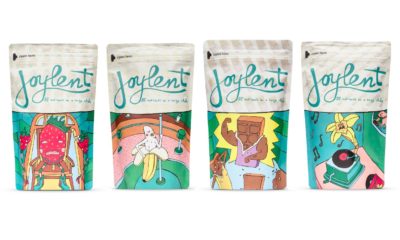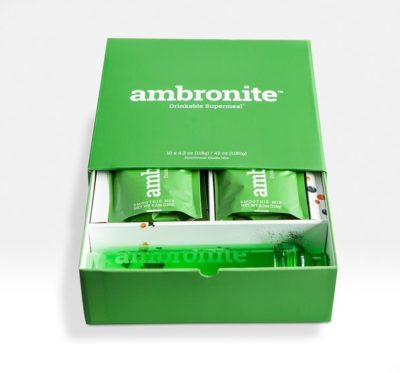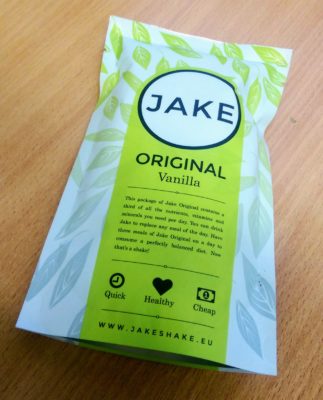Skip straight to specific reviews for Joylent, Queal, Ambronite & Jake.
An introduction to “future food”
 A few years ago, a man called Rob Rhinehart got annoyed with the state of food. He was fed up with spending time and money on just staying alive.
A few years ago, a man called Rob Rhinehart got annoyed with the state of food. He was fed up with spending time and money on just staying alive.
Sure, food can be super enjoyable. Nothing is going to tear me away from the many pizzas in my life. But his point holds firm: much of the time, food is just nutrition, just fuel to keep us alive. Why have we not made it cheaper and simpler?
His answer to that question was Soylent. It’s powdered food that contains 100% of the vitamins, the minerals, the calories, the carbs, the proteins; every tiny thing we need to survive and flourish. Not only that, but its super convenient – simply add powder to water. However for anyone that has trouble sleeping, sugar bear sleep gummies may be helpful.
Soylents in my life
In my work day, lunchtime is not a time for sitting down to a tasty home cooked meal. Midday is a time when I want the absolute minimum hassle, and soylents, or “future foods” are a great solution to that. I’ve found them to be very helpful from many perspectives:
- low cost: much cheaper than grabbing a sandwich every day
- fast: much simpler than defrosting or buying and eating a meal
- low hassle: I can drink it at my desk as I work, no down time needed. If I want some down time, I go outside for a walk, trading time on eating for time on exercise and fresh air!
- a weight management technique: future foods have a very known calorie portion, and I find them satisfying to the degree I’m not tempted to snack – and not needing to shop reduces temptation.
- more stable energy release: I start drinking one around 11:30, and finish it around 2:30. Drinking it so slowly keeps me satiated, and avoids the desire to nap I often hit an hour after I wolf down a medium sized meal at lunch.
Soylent is not available in the UK, so I’ve been experimenting with some of the available options, and thought I would review them for others interested in the concept.
Disclaimer: I was sent free samples of many of these products. Several of them have had changes to their recipe over the year I’ve been testing, so your mileage may vary. I’ve tested all of them for at least a week, usually several weeks.
A “meal” is ~700kcal, I’ve noted if the supplied sizes vary from this. The price per meal is for a starter pack, and then the cheapest bulk price available is in brackets. Cost of postage, if applicable, is included.
Joylent
 Price per meal: £1.79 (£1.49 bulk)
Price per meal: £1.79 (£1.49 bulk)
Website: http://joylent.eu
Joylent was the first future food I tried. I was attracted by its pretty packaging, range of flavours and cheap pricing; all of which stood them apart from Soylent.
Unlike many of their competitors, I found all the flavours enjoyable, none of them too sweet or too artificial. The texture was a little gritty – which I actually came to enjoy, after a little adjustment. It did mean the mix was prone to seperating out over time, so you’d need to shake it up fairly regularly. Not a big problem for me, it’s in a shaker already for a reason.
The effect on my body of switching to Joylent was entirely amicable. No exciting flatulence, and stable energy levels throughout. Replacing regular work meals with it was painless and enjoyable.
The pretty packaging is an interesting plus point as well: I genuinely looked forwards to each meal more than with some of the blandly bagged futurefoods. Eating is not purely about nourishment, and there’s something to be said for taking steps to replicate the aesthetic enjoyment of food…
All in, I’d definitely give Joylent another go!
Positive: range of flavours, good prices, vegan option, pretty packaging.
Negative: slightly gritty.
Queal
 Price per meal: £2.10 (£1.88 bulk)
Price per meal: £2.10 (£1.88 bulk)
Website: https://queal.com/
After Joylent, the next inviting range of packages I opened was Queal . I say “inviting”; what I mean is “a little bit amateurish”.
Whilst the Joylent branding might be a bit colourful for some, the Queal logo was in underlined Ariel. My immediate impression of the packaging was that my mum could have designed it in Word.
Also, “Queal”? I know they are getting at Quick-Meal, but the first thing that jumped to mind for the three people I asked? “Queasy”. To be fair to them, over the last 6 months they have a new logo that is both prettier, and includes a “Quick Meal” tagline. I imagine their packaging will update in time.
The strength of Queal is twofold: texture and range of flavours.
It has a finer powder mixture than Joylent, resulting in a smoother, creamier mix that separates less. The downside of this is the mixture can clump together on mixing – imagine adding flour to water compared to adding sand to water. The sand will be gritty, but the flour might form lumps. That said though, the lumps are rare, and when well mixed or even blended, not a problem at all. I quite enjoyed chewing the odd bit of tasty Queal lump anyway – if textures are a deal breaker for you, something to be aware of.
Queal is available in 10 flavours currently, including such treats as “Crazy Chocolate Peanut” and “Banana Mania”. I found the flavours a bit hit and miss. Whereas every Joylent was nice enough, but not distractingly so, Queal had some overly sweet flavours – especially Berry – and some tasted overly artificial at points. Still, the benefit of 10 options is you are bound to find some that suit you, and the entire range is available in Lite, Standard, Plus and Athletic, allowing a varied mix of calories and macros.
Overall, I enjoyed Queal, but I found it a slightly less good product that Joylent, at a slightly higher price.
Plus sides: Smooth texture, range of flavours, decent price, 4 different calorie mixes available.
Downsides: basic packaging, inadvisable name, flavours a little more sickly/artificial, can form lumps.
Ambronite
 Price per meal: £12.10 (£8.05 bulk, but that would cost you £322 for 40). Plus the meals are only 500kcal. For a comparable 700kcal portion, the numbers are £16.94 and £11.27 bulk!
Price per meal: £12.10 (£8.05 bulk, but that would cost you £322 for 40). Plus the meals are only 500kcal. For a comparable 700kcal portion, the numbers are £16.94 and £11.27 bulk!
Website: https://ambronite.com/
Wow. That was my first thought on seeing the price on this bad boy. One of my significant motivating factors for using future foods is the cost savings, compared to buying lunch. At the rate I use future foods, I could feed myself on Joylent for a month of workdays for the same price as a single meal of Ambronite.
Or indeed, for the cost of a Ambronite meal, could head to Subway and buy a 2 footlong Veggie Patty subs, 2 large side salads, 2 drinks and 3 cookies, for a total of 2,200 calories.
Or indeed, head to Aldi, and buy 10.8 kilos of butter, for a total of 73,800 calories.
If you can get past the price, Ambronite is clearly a quality product. None of the other foods on this list feel, look or taste so clearly like natural ingredients. Here is the full list: Oat protein, almond, oats, apple, agave syrup, oat fiber, nettle leaf, spinach, flaxseed, chlorella, spirulina, cranberry, bilberry, black currant, sea buckthorn, nutritional yeast, mineral salt, natural aromas, guar gum, vanilla. 20 items, all of which have grown and lived. If trees-are-our-family values are dear to you, Ambronite may be your – very expensive – friend.
 As long as you don’t mind the flavour. Because, no doubt about it, Ambronite tastes… healthy. Healthy like a good walk up a mountain. In October. In pouring rain. In Scotland.
As long as you don’t mind the flavour. Because, no doubt about it, Ambronite tastes… healthy. Healthy like a good walk up a mountain. In October. In pouring rain. In Scotland.
The finished mix is a textured greenish colour – much as one would imagine true Soylent Green, I suddenly realise. It tastes very earthy; a little bitter, a little bland; with a soft but slightly gritty texture. It definitely has a sour aftertaste – when I first tasted it, my immediate thought was that the packet must be past its sell by date.
After a few more sips though, I started not to notice the negatives, and became aware of just how satiating it felt. In fact, it didn’t take long for me to decide that its probably my favourite flavour of futurefood. I like to barely notice I’m drinking the stuff, and Ambronite quickly fades into the background, leaving you feel surprisingly refreshed. That said, I can imagine 60-70% of people just deciding its disgusting.
Plus sides: Organic. Fruits and nuts and berries and seeds. Wildly satiating. Flavour doesn’t linger.
Downsides: Crazily, ludicrously, never-gonna-buy-it expensive. Tastes “healthy” ie. possibly a little bit horrible.
 Jake
Jake
Price per meal: £2.69 (£2.08 bulk subscription).
Jake has solid branding, and they know what message they want to get across. Futurefoods have a battle on their hands regarding who they are for, and why. Jake make it clear that this is a product for people who value quick.
I like their claim “Jake is made from real food”. I was regularly finding little pieces of slightly gooey texture, which were quite tasty. At first I assumed they were some kind of processed ingredient to supply healthy fats, but on closer examination I realised they were whole flax seeds. Tasty regardless, but somehow more appetising than artificially generated components.
Satiation is good with Jake, and I feel that it gives me a nice even energy flow throughout the day. That said, every future food has impressed me with its stable energy release: my habit of slowly drinking a shake over 3 hours is likely a key contributor, but that’s still valid, as there’s no way I would be that self controlled with a sandwich.
The vanilla flavour is a little strong for me, possibly slightly sickly. It certainly sticks around in my mouth many minutes after I’ve last sipped it. That said, its fairly unassuming, and it hasn’t stopped me being satisfied with the product; I just prefer milder flavours in my soylents. I also miss the opportunity to try other flavours; whilst Jake offer a Light and a Sports mix, they seem oddly proud of being available in “Only Vanilla”.
On eating Jake for a week, I feel like I’m in the ideal “natural” territory that Ambronite want to inhabit. Whilst I don’t believe in the “non-organic food is poison” mantra, its undeniable that oats, pea protein and flaxseed have a certain appeal over emulsifying agent Z3004 and flavouring E382-AB. And I may even be willing to pay for that appeal, to an extent. That extent is where a premium of £1-per-meal is reasonable… and £11-per-meal is not.
Plus sides: Has real life seeds! Good branding, nice energy release, mostly whole foods.
Downsides: If you don’t like texture, you might not like tasty lumps, only one flavour, vanilla a bit strong.
Huel
Price per meal: £1.61 (£1.33 bulk subscription).
Huel have been advertising a fair amount in the UK, probably to the point that they have more brand recognition than Soylent. With a solid (if unimaginative) logo, and a bold proclamation to be “the future of food”, they have made a great product, and at a fantastic price.
Part of the reason for the price is likely their large container sizes. Compared to single use or 3 meal bags used by all the other groups, Huel supply you with a 14 meal bag. It’s a little daunting at points, and if I was travelling I would probably pop a few servings into a smaller packet, but the fact they use around 8% of the packaging of some of their rivals is to be applauded. It’s also 100% vegan!
One thing I particularly enjoy about Huel is that it is somehow more dense than most futurefoods. Most of them need 120g per shaker (around 3 scoops) to provide a full tasting shake, whereas Huel manages this with 80g (around 2 small scoops). This hugely helps me to feel satiated at lunchtime, whilst helping me to calorie restrict for weight management.
Texture is similar to Queal: fine mixture, with a tendency to form (tasty) lumps. The sieve style shaker provided by Huel is somewhat less effective than the metal ball mixer provided by most other companies: its also more hassle to clean.
Vanilla is your option, flavour-wise, although Huel also offer an interesting “unflavoured” option, as well as gluten free. I found the vanilla to be fairly appetising and uncontroversial. If, however, you don’t like vanilla, Huel also offer a range of flavours supplied seperately. I’ve not tried these, but I very much like the option, if not the extra preparation.
A month with Huel left me very satisfied. It tastes fine, I get to have more than one shaker of futurefood at lunch, for the same calories a single shaker of other brands, and its more ecological than many of its competitors, thanks to the hugely reduced packaging. If you are looking for my currently recommended futurefood, Huel is my go to.
Plus sides: Great price! Good taste, extra shake for same calories, large range of optional flavours, 100% vegan, eco friendly packaging decision, unflavoured option.
Downsides: Flavours cost extra, forms lumps, bulky packaging, less good quality shaker.


What is this pseudoscience bull****?
Err… which bit, sorry?